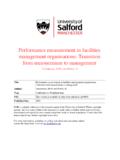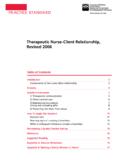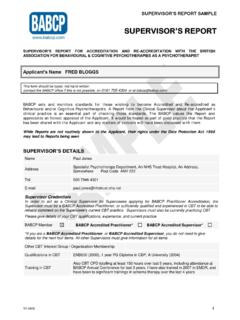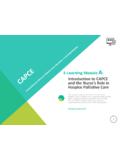Transcription of Developing effective therapeutic relationships with ...
1 Developing effective therapeutic relationships with children , young people and their families Roberts, JF, Fenton, G and Barnard, MC. Title Developing effective therapeutic relationships with children , young people and their families Authors Roberts, JF, Fenton, G and Barnard, MC. Type Article URL This version is available at: Published Date 2015. USIR is a digital collection of the research output of the University of Salford. Where copyright permits, full text material held in the repository is made freely available online and can be read, downloaded and copied for non commercial private study or research purposes. Please check the manuscript for any further copyright restrictions. For more information, including our policy and submission procedure, please contact the Repository Team at: journal : nursing children and young people Continuing Professional Development Authors: Jane Roberts, Gaynor Fenton, Michaela Barnard Aims and Intended learning Outcomes The aim of this article is to assist the reader to conduct a critical review of the therapeutic relationship between the children 's nurse, child and family, identifying areas for practice development.
2 therapeutic relationships can be defined in a variety of ways and compose differing components. By undertaking the time out activities you will be able to: Define the term therapeutic relationship ' from a child, young person, family and nurses'. perspective Discuss the key skills required to develop an effective therapeutic relationship Discuss the roles and responsibilities of nurses in the development of effective therapeutic relationships when caring for children , young people and families Identify challenges to the development and maintenance of a therapeutic relationship within children and young people 's nursing Review how the 6C's can enable nurses to clarify and apply the key components of therapeutic relationships . Introduction A therapeutic relationship between the children 's nurse and the child and family is defined as, purposeful, respectful, based on caring with recognition of the unique qualities of the child and family and one that is guided by professional boundaries.
3 The therapeutic relationship is a fundamental principle of nursing , described as a connectedness, essential to meeting patients' needs (Baughan and Smith 2009). To enable connectedness the nurse relates closely to the child and family's experiences, interpretation of events, challenges and needs and helps them to feel heard and understood. What is done with and for the child and family is undertaken respectfully and with regard for their concerns. The effectiveness of this relationship can impact both positively and negatively upon the quality of the physical, psychological and emotional care provided by the nurse .The nature of the therapeutic relationship influences the ability of the nurse to provide high quality care which is co-ordinated around the needs and wishes of the child and family.
4 The nurse can strive to achieve a high degree of quality and rapport, by demonstrating genuine interest toward the child and the family with sensitivity to all aspects of verbal and non-verbal communication. These characteristics are paramount to the development of a trusting and collaborative therapeutic relationship . It is argued that the quality of the relationship between the nurse, child and family, is far more important than the use of any specific communication skills (Hough 2008). Empathy, genuineness and a non-judgemental approach are key characteristics for the development of trust and rapport within relationships (Rogers 1951). Numerous strategies exist that nurses can access to develop their knowledge and skills in effective relationship building.
5 For example, communication skills such as active listening, paraphrasing, summarising, reflecting and questioning are fundamental to the development of rapport and empathic therapeutic relationships (Hough 2008, Sanders 2011, Nelson-Jones 2012). With maturity, the child increases understanding and autonomy, influencing involvement in personal care decisions (Coyne et al 2010). children are often reliant upon adults to make decisions on their behalf as they may lack understanding of illness and treatments and this in turn creates challenges for nurses (Duderstadt 2014). The nurse must continuously monitor relationships with children and young people , recognising the child's undoubted vulnerability, whilst assessing and addressing all aspects of physical and emotional care.
6 The National Service Framework for children , young people and Maternity Services (DoH 2004) advises that children and families should be respected and listened to in order to fully participate in care decisions. This advice is reiterated in the Compassion in Practice document (DoH 2012) with the introduction of the 6 Cs for nursing . The importance of communication and compassion in relationships cannot be underestimated and will assist nurses to ensure the adoption of the principle, no decision about me without me (DoH 2012). Family centred care is a key concept in children 's nursing , suggesting that children and families should consent and be actively involved in care decisions resulting in an agreed understanding between all stakeholders (Davies and Davies 2011).
7 children 's nurses must recognise the child as a pivotal member within the family unit ensuring that the therapeutic relationship extends to parents and the wider family, thus embracing the principles of family centred care. Figure 1 provides a diagrammatic summary of aspects of the therapeutic relationship . Figure 1 The therapeutic relationship Key characteristics of an effective therapeutic relationship Nurses must establish and maintain dynamic, reciprocal, therapeutic relationships , not only with the child but also their family. The NMC (2008) recognises this dynamic and advises nurses to be motivated to build trusting relationships with children , young people and their families. Factors that influence the development and maintenance of trust within these relationships include the child and family's previous experiences and familiarity with the care situation (Bach and Grant 2009).
8 Key elements suggested for an effective therapeutic relationship include trust, honesty, caring, support, empathy and respect for the client (Rose et al 2012). Ultimately the effectiveness of this relationship is the nurses' ability to communicate in a professional and caring manner. Nurses require an understanding, not only of the child's needs but also those of his family, as these are inextricably linked. Parents have a unique insight into their child's normal behaviour and they will recognise subtle signs of illness and distress (Chapman 2012). In valuing such insights from the child's family, the nurse can build trust, demonstrate respect and empower families to be actively involved in their child's care. Thus, an adaptable approach by the nurse can enhance the care provided ensuring that the focus is always on the child and family being active participants of care rather than being passive recipients (Warner 2006).
9 Collaboration with the child and family is essential in achieving agreed health outcomes. Acknowledgement of the family's role in decision and treatment choices is a crucial aspect of a professional therapeutic relationship and a method of ensuring a collaborative approach to care. Collaborative care requires a high degree of self-awareness from the nurse. The concept of self-awareness has been well documented in nursing literature (Burnard 1998, Freshwater 2003) and is described as the ability of the nurse to monitor their effectiveness whilst simultaneously interacting with the patient. Reflection upon interpersonal skills within the therapeutic relationship is paramount to the provision of empathic and individualised care. The nurse must demonstrate trustworthiness to the child and family, and this can be achieved by displaying professional attributes such as reliability, maintenance of confidentiality and accepting behaviours (Briggs 2006).
10 The aim of the relationship should be to ensure that the child and family have a good understanding of factors that influence their health alongside the care required (Bach and Grant 2009). Now do time out 1. 1 Characteristics of a therapeutic relationship Time You are a newly qualified children 's nurse on a busy day case ward. James is a 7. Out year old child you are caring for during your shift. James has some learning difficulties and has limited hearing and eyesight. He communicates via a form of sign language. You discuss his care with his mother who is present on the ward and enquire how you can effectively communicate with James to determine his preferences. The mother praises your care and concern for her son to you and your mentor.


















